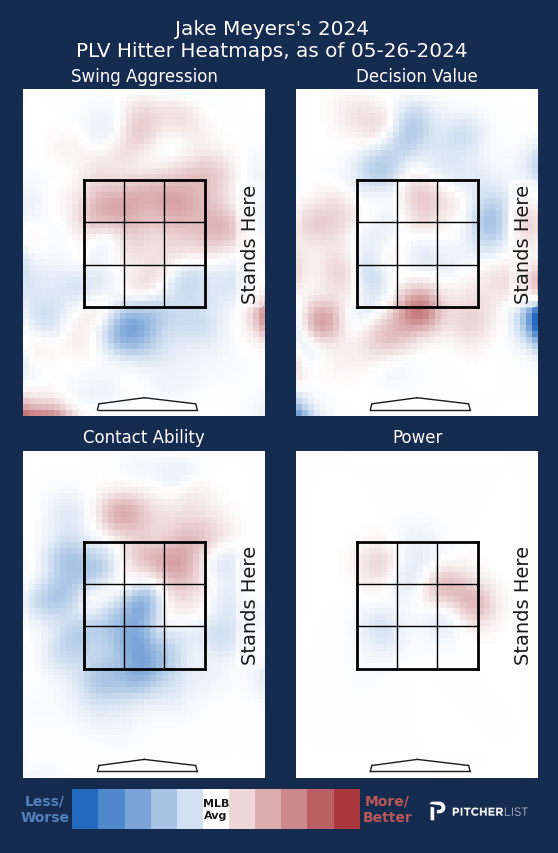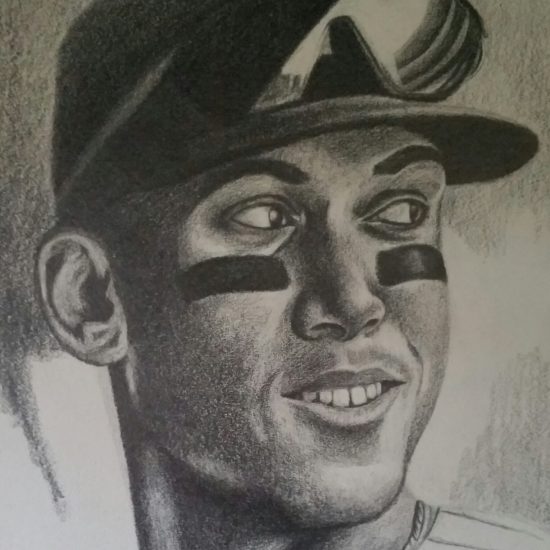In-season analysis can be hazardous. I’ll admit, having done it for a couple of seasons now, there is a Sisyphus-like nature to it. Trends, rolling graphs, etc. lead me to think a certain way and then the boulder comes rumbling down the opposite slope, turning everything I thought I knew into dust. What looks like a pattern is often my goldfish of a brain trying to find order amidst the chaos or entropy or whatever you’d like to call it. For example, a player who looks like they might be turning the corner by chasing less frequently, hitting for more power, or what have you ends up being nothing more than a mirage.
Ultimately, it’s important to keep in mind that this is all how things look right now, and not necessarily an indication of how things will end up although sometimes trends line up nicely and that’s fun. Ultimately, PLV metrics are a way to get a better, more intuitive description of the results so we can assess players and manage expectations for this fun game that we play.
As we steam into June, (can you believe it?) we’re starting to see quite a few hitters reach a sample size that we can start to sink our teeth into (400 pitches for DV, 200 swings for contact ability, and 75 BBE for power). This week we’ll survey a few hitters who have had varying degrees of success, two who are in dire straits, and two who are facing an increased opportunity.
If you’re new to PLV metrics, be sure to read Nick’s primer here. All the metrics are normalized to 100. Decision Value (DV) has also been further broken down this season into zDV (inside the zone) and oDV (outside the zone).
Note: PLV Stats are current through Monday, May 27th.
The rookie has been a spark plug for the Cardinals and is riding a 16-game hitting streak (through 5/27), putting him one behind Albert Pujols and Jordan Walker for the club rookie record. The hot stretch has earned him a couple of cameos as the leadoff hitter against left-handers.
Winn’s contact-ability is approaching two standard deviations above the average. However, his power is well below average (29th percentile xwOBACON). His plate approach is about average as a whole with above-average swing decisions inside the zone (107 zDV) but chases a little more often than you’d probably like (94 oDV).
Winn doesn’t walk as often as a prototypical bat at the top of the order, but his athleticism and contact ability pressure the defense and could be just what the doctor ordered for a stagnant Cards offense. He’s made a few cameos as their leadoff hitter against left-handers (he’s leading off against Andrew Abbott as I write this), but I’m curious to see if he gets a bigger opportunity moving forward.
We go from one rookie thriving to one who hasn’t gotten a hit since May 8th, although he did miss a few games with back stiffness. Regardless, Carter is out of sorts right now. His sharp batting eye earned him the nickname “Full Count Carter.” However, that might be hurting him now. His oDV is about a standard deviation above average but his swing decisions inside the zone are dragging him down in a big way.
This reminds me of what we saw from Gunnar Henderson last year when he struggled out of the gate with a very passive approach but ended with a more balanced approach (-1.6% Swing Aggression) en route to bagging the AL RoY. Maybe we’ll see something similar with Carter. Granted, Carter is a different player and doesn’t have Gunnar’s power, but this feels like a sink-or-swim moment where he’ll have to prove that he can keep pitchers honest by pulling the trigger on hittable pitches in the zone. However, we’ll have to wait a little to find this out with him being placed back on the IL.
Meyers has been dynamite for the Astros, hitting .381 with a 1.112 OPS over his last dozen games. The big difference has been a jump in power (94 last season; 220 BBE). The EV gains are impressive, culminating in a 73rd percentile xwoBACON.

The one blemish is that he’s lost a little contact ability (94 last season; 634 swings). Meyers does his damage at the top third of the zone. However, his contact heat map reveals a lot of blue around the middle of the plate, so there’s a pretty decent chance the nearly seven-point drop in his K rate that we’ve seen this year might not last.
We looked at Goldschmidt briefly in our first article when he was off to a brutal start. The results have been in his favor lately, hitting .298 with four home runs over his last 11 games. However, his power remains down from last year (114; 423 BBE) and oddly enough it has trended down albeit slightly (-1.1) over his last 300 pitches faced.
The near eight-point jump in his K rate seems like the elephant in the room. But his contact ability hasn’t dropped much relative to last year (92; 2,766 pitches faced), so I’m still cautiously optimistic that his strikeout rate will drop from here. On that note, he’s demonstrated increased contact ability (+2.7) over his last 300 pitches.
I was very excited for Julien heading into the season and sure enough, I have jinxed him into oblivion. Julien and Carter are similar in that they’ve had trouble stemming from passive approaches with questionable swing decisions inside the zone. Julien was always a passive hitter and this year we’ve seen his swing aggression drop two points.
Julien has demonstrated good pop with the ability to take advantage of pitches that he can drive to his pull side. Part of the reason I was fond of Julien was that he doesn’t chase (127 oDV). However, if you look at Julien’s swing aggression heat map, you’ll notice a lot of blue on the low, outside corner. Not surprisingly, pitchers have noticed it too, and I think that explains at least a part of his struggles. It’s a free square for pitchers to get ahead in the count.

His contact ability, over a standard deviation under the average, hasn’t helped. However, he can overcome that. Max Muncy is a potential blueprint. Muncy has demonstrated poor contact ability (76) but has benefitted from a more balanced (-4.5% swing aggression) approach.
Over his last 300 pitches, Julien’s contact ability has dipped (-3.6) with an even bigger decline in power (-7.0). So, yeah, things aren’t looking great now, to put it nicely. But let’s see if Julien can swim out of this rip current by upping his swing rate while keeping pitchers honest on the outer edge.
Nootbaar is hitting just .227 and is only 36% rostered on Yahoo, so there might be a buy-low window here. Nootbaar’s profile is rock solid across the board, the only blemish being his tendency to let too many hittable pitches go by (90 zDV). However, that’s a huge improvement from last year (48 zDV; 716 swings). His chase rate is as good as it gets and he’s also shown more pop compared to last year (101; 319 BBE).
I wish what happened Sunday never happened. But here we are. In the meantime, it’s an opportunity for someone else to step up. It’s a little short of the sample size we’re looking for, but the early returns point to Duvall potentially being a decent add in five OF leagues needing home runs. Again, this could turn to dust but Duvall’s power is comparable to last year (124; 213 BBE) and as a bonus, his contact ability is way up relative to last season (98; 635 swings). He’s also been more selective with an improved oDV compared to 2023 (85; 1,313 pitches faced).
Just as an aside, Michael Harris II is hitting leadoff against right-hander Jake Irvin. We’ve seen Harris be productive there but his chase rate has bottomed out this season with a 61 oDV (80 oDV last year), so I’m curious to see if this sticks.
He should get added opportunities but his profile right now isn’t too exciting. This year, his power has leveled off (106 last year; 241 BBE), and the approach gains he showed early last year with the Mariners are a distant memory. You could make the case that there’s untapped potential as a 24-year-old former top prospect, but right now, the results aren’t there. Still, there’s a good opportunity in front of him so let’s see what he can do.
Deep League Darts
It’s a perilously light sample of 26 BBE but Mark Vientos is bringing the power (127). Brett Baty, meanwhile, hasn’t done a whole lot (98 power; 100 BBE). Vientos’ defense has hurt him, but he’s got thump worth putting on your watch list.
Former Reds prospect (decades ago, I know) Nick Senzel is getting everyday at-bats for the Nats and is showing some pop (110; 66 BBE).
Speaking of former prospects can I interest you in Andrew Vaughn? Absolutely not, he’s hitting .196 as the White Sox cleanup hitter. Fine. Well, he’s at least shown more power over his last 300 pitches (+7.7). Keep an eye on him, maybe? No! Alright, fine.
After having three stolen bases across 600 career games, 30-year-old Jesse Winker has finally found his calling as a base stealer. Ignoring the seven steals, he’s shown his usual disciplined approach (120 oDV, 101 zDV) but with below-average contact (94) and average-ish power (98). He’s a solid add in OBP leagues but probably more of a fringe option in standard 5×5.
Photo by Brian Rothmuller/Icon Sportswire | Featured Image by Ethan Kaplan (@DJFreddie10 on Twitter and @EthanMKaplanImages on Instagram)

